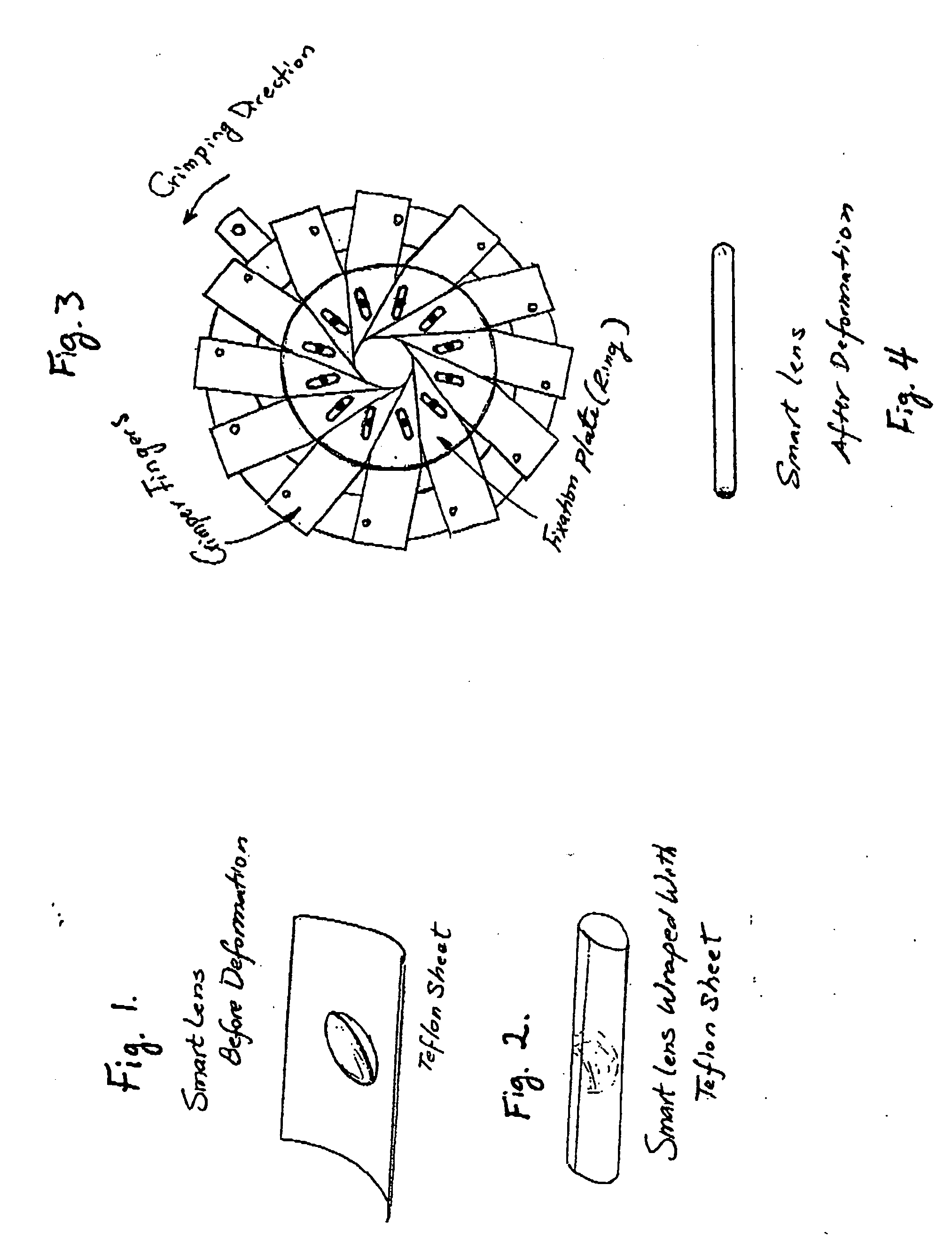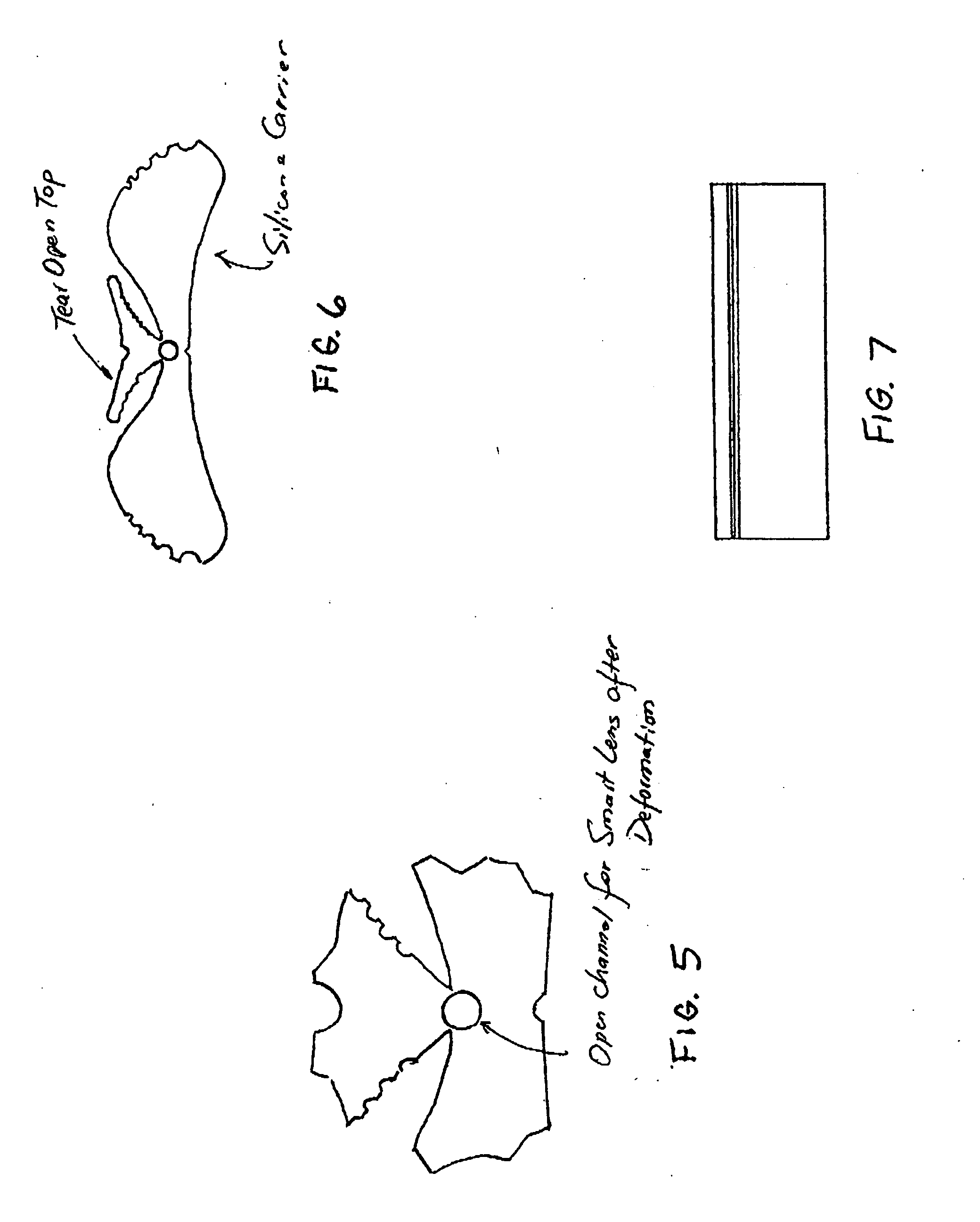Apparatus and method for implanting intraocular lens through a small incision
a technology of intraocular lens and incision, which is applied in the field of apparatus for deformation, packaging and inserting iol, can solve the problems of increased potential for intraocular infection, long healing time, and induced astigmatism
- Summary
- Abstract
- Description
- Claims
- Application Information
AI Technical Summary
Benefits of technology
Problems solved by technology
Method used
Image
Examples
example 1
[0035] A full-size intraocular lens of the type described in U.S. Pat. No. 6,679,605 (Zhou, et al), incorporated herein by reference, is produced with an equatorial diameter of 10 mm and a central lens thickness (the distance from the apex of the anterior lens surface to the apex of the posterior lens surface) of 4 mm. The lens is placed on a 0.005 inch thick sheet of polytetrafluoroethylene and coated with a layer of a 10% solution of hydroxypropylmethyl cellulose in water. The sheet is rolled into a tube with the lens at the center of the tube. The tube is placed into a crimper mechanism of the design described in U.S. Pat. No. 6,629,350 (Motsenbocker). The radially distributed arms of the crimper gradually and evenly compress the lens shape into a long, thin rod. The thermoplastic sheet protects the sensitive lens surface from being damaged by the crimper mechanism. The mechanism is submerged into a 0° C. water bath and held there for approximately 5 minutes, allowing the lens po...
example 2
[0036] A full-size intraocular lens of the type described in U.S. Pat. No. 6,679,605 (Zhou, et al) is produced with an equatorial diameter of 10 mm and a central lens thickness (the distance from the apex of the anterior lens surface to the apex of the posterior lens surface) of 2.2 mm. The lens is placed on a 0.005 inch thick sheet of polytetrafluoroethylene and coated with a layer of a 10% solution of hydroxypropylmethyl cellulose in water. The sheet is rolled into a tube with the lens at the center of the tube. The tube is placed into a crimper mechanism of the design described in U.S. Pat. No. 6,629,350 (Motsenbocker). The radially distributed arms of the crimper gradually and evenly compress the lens shape into a long, thin rod. The thermoplastic sheet protects the sensitive lens surface from being damaged by the crimper mechanism. The deformed lens, while still inside the crimper, is submerged into a 0° C. water bath and held there for approximately 5 minutes, allowing the len...
example 3
[0037] A three-piece IOL is prepared from the same composition as Example 1 of the U.S. Pat. No. 6,679,605 (Zhou, et al). The lens is warmed at 50° C. for about one minute and then placed on a 0.005 inch thick sheet of polytetrafluoroethylene and coated with a layer of a 10% solution of hydroxypropylmethyl cellulose in water. The sheet is rolled into a tube with the lens at the center of the tube and with the two haptics at each end of the roll. The tube is placed into the same crimper as described above, and after following similar steps as in Example 1, a rod with a diameter of about 1.5 mm and length of about 11 mm is obtained. This whole rod is successfully delivered into a capsular bag through a 2 mm incision in a cadaver human eye. Once warm saline is introduced, it recovers back to its original three-piece lens design inside the capsule.
PUM
 Login to View More
Login to View More Abstract
Description
Claims
Application Information
 Login to View More
Login to View More - R&D
- Intellectual Property
- Life Sciences
- Materials
- Tech Scout
- Unparalleled Data Quality
- Higher Quality Content
- 60% Fewer Hallucinations
Browse by: Latest US Patents, China's latest patents, Technical Efficacy Thesaurus, Application Domain, Technology Topic, Popular Technical Reports.
© 2025 PatSnap. All rights reserved.Legal|Privacy policy|Modern Slavery Act Transparency Statement|Sitemap|About US| Contact US: help@patsnap.com



